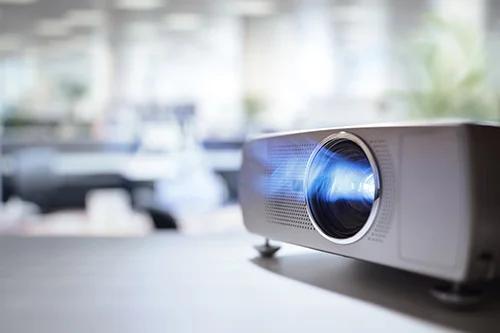
A sound understanding of throw distance calculations is crucial for integrating projectors in offices, educational institutions, and home entertainment systems. Knowing the science behind the calculations is the key to using projectors optimally. A projector’s throw distance is the distance between the projector and the image on the screen i.e. the distance that the image is “thrown” or “projected”. The projector position and the size of the image will depend upon your room configuration. Hence, you will need to consider the throw distance and the projector features that will give you maximum placement flexibility.
Understanding Projector Throw Distance
The distance between your projector and screen is a crucial element in setting up your presentation. The basic rule is the more distance you have between the projector and the projection screen, the larger the projected image will be. However, even this is limited as defined by the Inverse-Square Law where the luminosity decreases intensity as the light beam travels further. In other words, the higher the throw distance, the less bright the image will be. If the throw distance is considerable, make sure you have enough output (lumens) on your projector to do so.
Below are the 3 basic variables most affected by throw distance:
- Lumens – The brightness of the projector.
- Luminance Uniformity – The projector’s ability to spread an even amount of light over the projection surface.
- Picture Resolution – The clarity of the image.
As these variables are interdependent, it is worthwhile looking at these elements individually to get a deeper understanding of the science behind the projector throw distance calculation.
Lumens
The correct full name is “ANSI Lumens”. It is the standard measurement of brightness emitting from your projector. Lumens are the units of measure for the amount of light that a projector is reportedly able to produce. The averaged multiple readings of visible light from various angles to determine a standardized unit of measure known as ANSI (American National Standards Institute) Lumens.
Mathematically, it is a measurement of one candela of visible light per square radians (1 candela * sr) Symbol = lm. To put it into easier terms, a candela is about the equivalent of the light produced by one candle. The candela actually replaces the obsolete measurement of the “Candlepower (cp)” and is equivalent to 1.02 cp units of measured visible light.
Luminance Uniformity
This is the process of ensuring how close a projector comes to putting an equal amount of brightness over the entire area of a screen. In other words, full 100% luminance uniformity would be when the projector distributes precisely the same degree of brightness over every measurable reference point on the projection screen. Typically, there are fluctuations of brightness diffusion so it is unlikely that the far corners of the projection screen are getting the exact same amount of light that the center does and vice-versa. That being said, a good projector will deliver about 85%-95% of luminance uniformity. Usually, the average human eye cannot tell the difference. Our suggestion is to avoid buying a projector with less than 85% luminance uniformity; especially if you are planning to project onto a screen that is about 100 inches (diagonally) or larger.
Picture Resolution
Resolution really places a limit on the amount of throw distance. As stated earlier, the greater the distance, the more light spreads out. Modern video content is digitized meaning that each picture is made up of a large count of individual points of light called “pixels”. If you have a low-resolution projector, those small pixels become big and blurry real fast. Resolution is the level of clarity that is achieved in a video image. The more pixels you can fit into a certain place, the more detail you will have. The illustration below shows in real-time the size increase of each box using pixels that are of the same size.
Different projector types that throw distances
Long Throw: These projectors provide very large images, this type of throw is usually from projectors that are installed in the center of the ceiling in a large room. They require the greatest amount of distance to make an image. Standard Throw or “Long Throw” Projectors are the most common types of projectors found in most installations.
Short Throw Projectors: These projectors provide large images while reducing shadows and eye glare, this type of throw is usually seen from projectors either installed on the wall or the ceiling closer to the wall anywhere that is close to where the image will be projected. Short-throw projection generally refers to a distance between 3 to 8 feet away from the projector to screen.
Ultra-Short Throw Projectors: These projectors virtually eliminate shadows and eye glare. This type of throw is seen from projectors installed on the wall, the ceiling closer to a wall, or a table projecting downwards. Ultra-short-throw projection refers to a distance between 0 to 4 feet away from the projector to the screen.
Considering the important factors such as brightness, uniformity and resolution are the key factors. One should always keep in mind the importance they carry and go for the projector that fulfills their requirements. The greater the distance, the bigger is the picture. And likewise, the higher the number of lumens, uniformity, and resolution, the more equipped the projector is for delivering a bigger picture.
Lumina Screens have a range of products that are optimum for every kind of projection — regardless of which projector one chooses to go with. Lumina Screens’ unique treatment which goes into the manufacturing of each of its products makes sure that your viewing experience at home remains the best of all.
- Date - July 31, 2019